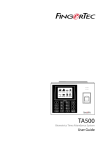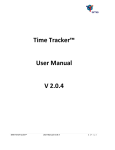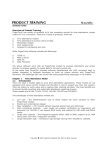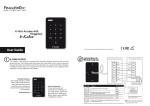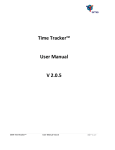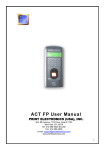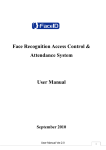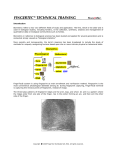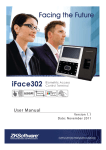Download Webster user manual
Transcript
Easy Data Centralization with Webster User Guide CONTENTS 3-4 1 • Introducing Webster Webster - An Introduction 5-14 2 • Installing & Configuring Webster 15-18 3 • Managing FingerTec Terminals in WebsteR 19-21 4 • Managing Users in Terminals & Webster Installing the System Configuring Webster Adding Terminals into Webster Editing Terminals in Webster Deleting Terminals in Webster Searching for Terminals Controlling the Terminals Understanding the Basic Information of Webster Uploading, Transferring, and Exporting User Data Searching for Users Editing and Deleting Users 22-23 5 • Managing Transactions Logs in Webster Sorting Transaction Logs Exporting Transaction Logs Reading Transaction Logs 24-26 6 • Checking the Webster Command and System Log 27-28 7 • Real-Time Transaction and Users Webster Command System Log Monitoring Real-Time Transactions Monitoring Real-Time User Enrollment 29-33 8 • Managing, Administrating, and Maintaining Webster Managing Administrators Managing & Maintaining the Database 1• Introducing Webster Webster – An Introduction FingerTec Webster is a web platform that facilitates all FingerTec terminals to be integrated with a web application. It is built on the latest Microsoft Technology, Visual Studio .NET 2010 with the .NET Framework 4.0 as the system architecture, and runs on Microsoft Internet Information Services (IIS), supports MySQL database, and centralizes data from all FingerTec terminals through web to server in a real-time manner. To use Webster, you will need to perform the installation at a server with a static IP address (Webster IP) to work as a host for FingerTec terminals to connect to. With Webster, FingerTec terminals can be installed at any location and still be able to connect to Webster as long as the terminals are connected to the server via LAN or WAN. Once the Webster IP is inserted in the terminals, the Webster User Interface would show the terminal status as Online. The terminals will start to send data (e.g. User data, enrollment, transaction records, etc.) in real-time back to Webster through an active connection. In the event of a connection failure, the terminals will store the data into a buffer memory and resume sending the data once the connection is established again, hence avoiding any loss of data and records. Take a look at the diagram below for a better illustration: TA103R router router 192.168.1.2 Branch 1 TCMS V2 Software router Internet Websterserver router 192.168.1.3 Third Party Software 219.93.242.2 TA200 Plus Branch 2 Internet router WAN Web Based Client Webster consolidates the data from FingerTec terminals into the MySQL database of the same server. MySQL is one of the most popular, reliable and fast open source database that facilitates software integration and data extraction. Software specialists will be able to integrate the raw data into their existing software or system, thus producing a complete and automated time attendance processing and third party software integration. To sum it up, Webster is a web based intermediate that links up FingerTec terminals, the MySQL database and a 3rd party software into a total web-based solution which allows access to users at anytime and any location via an Internet browser. To highlight the differences between the conventional connection method and the Webster connection method, refer to the table below. CONVENTIONAL CONNECTION WEBSTER CONNECTION • Data is stored in each individual FingerTec terminal. • Data will be centralized and stored in the Webster server. • Data is uploaded to the Webster server in a real-time manner. • TCMSv2 along with any third party software will be able to login to Webster to download data for processing. • Once Webster is installed on the server, all terminal management will be web-based. There’ll be no need for additional installations on the client PC. • After the installation of Webster, simply configure the terminals at multiple-sites to connect to the Webster server. • Data will need to be downloaded into the TCMS V2. • Data is downloaded into a single TCMS V2 software making it difficult to enable data sharing between applications. • An installation of the TCMSv2 or BioBridge is a must to control and manage the terminals. • For multiple-site installation, configuration on the router / port forwarding needs to be done at each router on each site. Webster provides a User Interface for system administrators to browse the attendance records stored in the MySQL database. This will be raw data downloaded from the terminals, which show the user ID, date, and time of verification. The system integrator and software developers can fully utilize the records from the MySQL database, to process time attendance analysis and payroll calculations accordingly. Webster also provides a simple User Interface for system administrators to transfer user data among FingerTec terminals. Users will not need to re-enroll at new terminals should they relocate to a new workstation / office. This is useful for companies with multiple branches and outlets where employees relocations are common and often occur. Note Webster is not a complete time attendance solution. It is only an intermediate to facilitate FingerTec terminals into a web-based management, and consolidate data into a centralized database. It does not provide any attendance analysis, but only raw data viewing line by line. It does not provide attendance reports, because it is not integrated with any calculation logic. It cannot change any access control settings in FingerTec terminals, such as time zones, door lock settings etc. For more optimized and advanced time attendance and access control configuration, FingerTec recommends that you use the complimentary bundled software, TCMS V2 or the web-based attendance solution, TimeTec. 2• Installing & Configuring Webster Installing the System For Webster to function properly, these components need to be installed first: Information Services • Internet .Net Framework 4.0 • Microsoft server • MySQL Connector ODBC 3.51 • MySQL • FingerTec Webster Make sure the server has been installed with the above components before attempting to install Webster. The install shield will run a test to check that the components have been installed before proceeding with the installation. Installing the Internet Information Service (IIS) The IIS comes with the Windows Operating System and should be installed by the administrator. To install it, follow the steps below. Go to Control Panel > Program & Features > Turn Windows feature on or off > Check Internet Information Service checkbox to install IIS > Follow the on-screen instructions to finish the installation of IIS. installing Microsoft .Net Framework 4.0 Download the installation file at http://www.microsoft.com/download/en/details. aspx?id=17851 > Run the installation file and follow the instructions to start to install Microsoft .Net Framework 4.0 Read and accept the license agreement > The installation requires an Internet connection to download and install the component into the server. Make sure an Internet connection is available. > Follow the on-screen instructions to complete the installation. installing the MySQL server v5.5 Webster requires the MySQL server version 5.5 to run smoothly. Download the installation file at http://www.mysql.com/downloads > Run the installation file to begin installation. Click Next > Read and accept the License Agreement > Click Next to proceed. Select Typical > Click Install to begin the installation process. Wait for the installation of the MySQL to be complete > Check the checkbox to Launch the MySQL Instance Configuration Wizard > Finish > Start to configure the MySQL server. If the server is installed with an older version of MySQL server, the system will advise the administrator > Select to use the latest version, v5.5.8 > Next > Select Detailed Configuration and Click Next Select Developer Machine > Click Next > Select Multifunctional Database > Click Next Select Database Support (DSS)/OLAP > Click Next Select Standard Character Set > Click Next Uncheck Modify Security Settings if the administrator does not want to change the default login name and password of the MySQL server (default login name = root, password = <blank>) > Click Next If the Administrator would like to change the login name and password, check Modify Security Settings and insert login password to proceed. 10 Click Execute > Wait for the system to complete the configuration > Click Finish to end the process. installing the MySQL Connector ODBC 3.5.1 Webster requires the MySQL Connector ODBC 3.51 to work with the MySQL database. Download the installation file at http://www.mysql.com/downloads/connector/ odbc/3.51.html Run the installation file > Click Next > Read and accept the License Agreement > Click Next 11 Select Typical > Click Next > Click Install > Click Finish INSTALLING WEBSTER After successfully installing the previous components, you may proceed to install FingerTec Webster. Run the Setup.exe file to begin installation. For Windows Vista, Windows 7 and Windows 8 users, right click and select Run As Administrator to run the Setup.exe. Click Next and insert the relevant information. Click Next to continue. 12 Insert the IP address of the MySQL server. Insert “localhost” if the MySQL server has been installed in the same server. Insert the Login ID and Password to connect to the MySQL server and click Next. Select Complete and click Next to continue. Click Install to begin the installation. Once the process is complete, click Finish to continue. Now, Webster and its components are successfully installed into the server. 13 To run Webster: Open Internet Browser > Insert the IP address of the Webster server in the address bar (e.g. 192.168.1.201/Webster) > Fill in default login username and password (default login username: admin; password: admin) > Click Login. Configuring Webster Now that Webster is successfully installed, it is time to set some basic configuration. Click on System Configuration to start configuring the Webster. Auto refresh interval: Defines how fast Webster refreshes its database to publish the latest information. Real-time monitoring row: Justifies how many rows to be displayed as real-time records on a page. Number of grid rows per page: Justifies how many rows to be displayed on a page. You may configure the System Email Settings if the administrator would like Webster to send an email to the administrator if he/she forgets the login username and password. This function requires an SMTP Server address. Email: Email address to be used. Password: Login password of the email address. 14 3 • Managing FingerTec Terminals in Webster The Terminal List page displays all the FingerTec terminals that are connected to the Webster server. Searching a terminal by serial number, device name or IP address Basic command buttons Display table of device information. Adding Terminals into Webster The administrator does not need to add FingerTec terminals manually into Webster. The terminals connect to Webster automatically by referring to the Webster IP address which has been preset in the terminal settings. Set COMM option in the FingerTec terminal Insert IP address, Gateway and Subnet mask Insert Webster IP address (static IP address of the Webster server) Restart terminal to take effect. The terminal takes time to connect to the Webserver IP address. Once connected, the administrator will see the basic information of the terminal displayed on the Terminal List as below: Check the following settings if the page does not display any information of the terminals: • Internet connection – Make sure the Webster server and the terminals are connected to the Internet. • Firewall and Antivirus settings of the Webster server. • IP address, Gateway, Subnet mask and Webster IP address set in the terminal. 15 Editing Terminals in Webster Click the Edit button next to the relevant FingerTec terminals to edit the basic information of the terminals. Now the administrator can insert or change the Device ID of the terminals. It is recommended to name the terminals for easy reference, for example, “Time Clock at HQ”. Click Update to save changes. Deleting Terminals in Webster The administrator can delete any of the terminals via Webster if it is not in use. Click Delete and OK to confirm and delete the terminal. BATCH PROCESSING – DELETE OR EDIT In case the administrator wants to edit or delete multiple terminals, this can be done by batch processing: Select relevant terminals Select Batch Edit or Batch Delete Searching for Terminals An administrator can search for a terminal by its serial number, device number or IP address. Insert either one information into the relevant data field and click Search to find the terminal. The results will be displayed at the bottom in a table format (section ). 16 Controlling the Terminals Section lists the basic command buttons that allow you to interact with the FingerTec terminals. The administrator must select the terminals by checking the checkbox next to the serial number of terminal, then select the relevant command. Check reader: Identifies the connectivity status of the terminal, Online (terminal is connected to Webster) or Offline (terminal is not connected to Webster). It is advisable to check the connectivity status of the terminal before starting an operation. Reload Option: If an administrator changes any connection settings in the terminals, the administrator must refresh the information in Webster by clicking this button. Reboot: Restarts the terminal remotely. Get Info: Downloads basic information from the terminal and displays it in the table, for example, firmware version, algorithm version, total number of users, etc. Clear log: Deletes all stored transaction logs in the terminal. Once deleted, the transaction logs are unable to be restored or retrieved again. Only perform this operation if the terminal is almost reaching its storage limit. Make sure that you have already retrieved and stored all the transaction logs into the Webster server before performing this step. Clear All Data: Deletes all user information and transaction logs stored in the terminal. This is to initialize the terminal by emptying its buffer memory. Transfer Data To Device: to copy all user information from 1 terminal and transfer them to another terminal. Webster needs a LAN/WAN connection to send commands to the terminals. If the connection is disrupted or the terminal is shut down, Webster will not be able to send commands to it. In this situation, Webster will then keep and queue the commands and execute them? when the connection or terminal resumes operation. It is recommended to check the Real Time Webster Command page (Chapter 7 Monitoring) to check the status of the commands. In the example below, an administrator is trying to copy user information from Terminal ID 1 to transfer them to Terminal ID 2. The steps are shown below: 1. Select the terminal to copy data Click Transfer Data To Device 2. Webster will alert you to define the destination of terminal to transfer the data to. Select the terminal and click OK. The screen will display a Success message. However, the operation might be pending due to an unavailable connection. To double check the status, go to Real Time Webster Command. 17 3.Go to Monitoring Real Time Webster Command. In this window, Webster lists all the commands that are queued or completed. 4. When Webster completes the data transfer or any other command, the status will change to “Completed”. Always check the Real Time Webster Command to confirm the command is completed. For more explanation, view Chapter 6. Understanding the Basic Information of Terminals Section is the check list of FingerTec terminals. The administrator can view the details of the FingerTec terminals as it appears in the table. Serial no: 7-digit serial number of the connected terminals. Device ID: The Device number set in FingerTec terminals, varying from 1 to 999. No duplication of number is allowed. The administrator can set the Dev ID and update the changes to terminals. Device Model: The specific model of the FingerTec terminal. Description: The assigned name of the terminal for a more accurate reference, for example: Time Clock at HQ. The administrator can set the name of each terminal by editing the terminal information. Firmware version: The firmware version of the terminal. This is an important reference to a FingerTec technical person to troubleshoot the terminal during a system failure. The administrator does not have any authorization to edit this. Algorithm Version: The algorithm version supported by 18 the FingerTec terminal. Platform: The version of core board of FingerTec terminals. This is an important reference to a FingerTec technical person to troubleshoot the terminal during a system failure. The administrator does not have any authorization to edit this. Transaction count: Total transaction logs (attendance records) saved in the terminal. All of these logs have already been uploaded to the Webster database. The count is as an alert to the administrator about storage limit of the terminal. User count: Total users stored in the terminal. FP Count: Total fingerprints stored in the terminal. IP Address: The unique IP address of the terminal. Last Activity: The most recent upload time of terminal data (users or transaction logs) to Webster. Created time: The date and time that the terminal first connected to Webster. 4 • Managing Users in Terminals & Webster FingerTec terminals always uploads user information (user ID, privileges, fingerprints, passwords, and cards) to Webster after enrollment, and publishes it onto the User page. The process is fully automatic and does not require the administrator to regularly download the information from terminals. The User page is divided into 3 sections. Searching users by user ID, name or serial number of terminal. Basic command button. Table to display user data. Uploading, Transferring, and Exporting User Data Although user information is automatically updated from the terminals to Webster, the administrator can also add user information to the terminals via Webster by uploading and transferring data. UPLOADING USERS This process creates new users in the terminal without the user actually enrolling at the terminal. The administrator can upload user ID, password and Card ID to the terminal. To create and upload new users: Select terminal by serial number Create new user ID (does not exist in the terminal) Name the User Insert Card ID (optional) Define privilege Insert password (optional) Click Upload User. 19 UPLOADING TEMPLATES This process uploads fingerprint templates of users into the terminals. The administrator can copy and paste the fingerprint templates between terminals. To copy users’ fingerprint: Select terminal by serial number Select a user ID Select Fingerprint ID (number of fingerprint enrolled, start from 0 to 9) Copy content in the Template column To paste users’ fingerprint: Select terminal by serial number Fingerprint ID Select Valid Click Upload Template Select a user ID Select Paste the copied template into the Template column The fingerprint template is now uploaded into the terminal as the user’s fingerprint. TRANSFERRING USER DATA This process allows the administrator to transfer user data (user ID, fingerprints, cards, password, etc) among FingerTec terminals. This is to ease the process of enrollment so that the user does not have to repeatedly enroll at all the FingerTec terminals. To transfer users: Select users from the table terminal to transfer the users to Transferring user data does not delete the user data from any terminals. Click Transfer Data To Device Click OK to proceed EXPORTING USERS The administrator may export user information into a check list format for reference and record purposes. There are three formats that the data can be exported into which are csv, txt or xls format. 20 Note Select Searching for Users The administrator is able to search for user information on the Webster database. The users can be searched either by the User ID, Name or Serial Number of terminals that the user in enrolled into. Just insert either information into the data fiels and the results will be displayed in a table at the bottom of the page. Editing and Deleting Users The administrator has the authorization to edit and delete users in the Webster server and FingerTec terminals. Any editing or deleting operation takes immediate effect in the terminals. You may choose to edit or delete a single user, or multiple users at a time. To edit a single user: Click Edit next to the user ID column (optional) Select Privilege Define User Group automatically updates the changes to the terminal. Insert Name and Card ID Click Update to proceed Webster To edit multiple users: Select users Click Batch Edit at the bottom A new window will pop up Insert name and Card ID (optional) Select Privilege Define User Group Click Update to proceed Webster automatically updates the changes to the terminal. To delete one user: Click Delete next to the user ID Click OK to confirm to delete Webster automatically updates the changes to the terminal to delete the user. To delete multiple users: Select users Click Batch Delete at the bottom of the page Click OK to confirm to delete Webster automatically updates the changes to the terminal to delete the users. 21 5 • Managing Transactions Logs in Webster Every time a user verifies to report their attendance at a terminal, the transaction logs (attendance records) get uploaded to Webster immediately. This makes the Webster a realtime attendance recording server. In the event of a connection failure, the terminals then save the transaction logs into its buffer memory, to be uploaded to Webster the moment the connection to Webster resumes. The sorting data field Export button The table displaying transaction details Sorting Transaction Logs The administrator can choose to view the transaction logs by serial number of the terminals or by date range. To sort by serial number: Insert serial number of terminal into the Serial Number column Click Search Transaction logs will be displayed in a table. 22 To sort by Date Range: Insert the start and end date Click Search Transaction logs will be displayed in a table. Exporting Transaction Logs Transaction logs can be exported into CSV, TXT or XLS formats. The exported file can be used as data to be imported into a 3rd party software for further processing. To export transaction: Click Export Define serial number of the terminal Define start and end date Select format of export file Click Export to proceed. Reading the Transaction Logs Transaction logs in Webster can be retrieved and viewed by the administrator anytime. Each code/number represents an important piece of data: Serial no: The serial number of the terminal, which uploaded the transaction log User ID: User ID of the verified user Verify Code: The type of verification used (0 – card/password, 1 – fingerprint) Check Type: Status defined at the time of verification (indicated by the user during verification, 0 – Check In, 1 – Check Out, 2 – Break, 3 – Resume, 4 – OT in and 5 – OT Out) Work Code: The number inserted by users during verification to indicate the reason of attendance reporting. For more details see the explanation in the Hardware user manual for FingerTec models Check Time: Date and time of verification 23 6 • Checking the Webster Command and System Log The connection between Webster and the terminals can be affected by many factors, such as a congested or slow network, the shutting down of terminals, etc. These reasons cause the data transfer between Webster and the terminals to be delayed. As discussed earlier, in such situations, the terminals will save the data and transaction logs into the buffer memory and resumes the upload when a connection is established again. The same process is done by Webster. When the administrator is trying to send a command to the terminals when the connection is down, Webster will store the command into its own buffer memory and will resend the data when the connection resumes. It is advisable to check the page Webster Command to see the status of command, which will be one of the following: Completed: Webster has completed the data upload or commands to the terminals. Pending: Webster is waiting to upload data or send commands to the terminals. The Webster Command page also displays other important information, such as: Serial no: Showing which terminal Webster will be connecting to Command: Displays he name of the command or data transfer between Webster and the terminals Status: Show the status of the commands: Completed or Pending 24 Request time: The date and time that Webster started to send the data or command Response time: The date and time that the terminal responded to Webster Complete time: The date and time that the data transfer or command is completed (only appears if Status = Completed) These logs are important for the administrator to be informed of the communication status between Webster and the FingerTec terminals. The administrator can filter the logs according to the serial number of terminals, or types of status. Webster Command The records in Webster Command are all historical records and not real-time logs. It is recommended that the administrator view the Real Time Webster Command page (under Monitoring) to view all real-time commands/data transfer between the terminals and Webster. System Log System log refers to administrative records stored in each terminal. It records any operation done by the administrator, for example, registration of a new user by fingerprint. The administrator will not be able to see these records at the terminal itself. However the terminal saves these records into its buffer memory, and uploads them to Webster when a connection is established. These records can be viewed and read by clicking on Terminal System Log. 25 The Terminal System Log page is displayed in a table format. Each column displays the following: Serial number: The serial number of the terminal that sent the system log to Webster Log time: The date and time that the operation occurred Description: The operation done at the terminal Created time: The date and time that the record was uploaded to Webster If the administrator would like to monitor the real-time operations occurring at the terminal, go to the Real Time Terminal System Log page under Monitoring for details. Whenever an operation occurs at the terminal, the administrator will be informed immediately. 26 7 • Monitoring Real-Time Transactions & Users Monitoring Real-Time Transactions Real Time Transaction is a page that displays real-time verifications that occur at the terminals. Webster receives and publishes all transactions received from connected terminals to inform the administrator about activity at the terminals. The transactions are displayed in a table format which contains the following columns: Serial no: The serial number of the terminal which uploaded the transaction log. User ID: The user ID of the verified user. Check Type: Status defined at the time of verification (indicated by the user during verification, 0 – Check In, 1 – Check Out, 2 – Break, 3 – Resume, 4 – OT in and 5 – OT Out) Verify Code: The type of verification used (0 – card/ password, 1 – fingerprint) WorkCode: The number inserted by users during verification to indicate the reason of attendance reporting. For more details see the explanation in the Hardware user manual for FingerTec models Check Time: Date and time of verification 27 Monitoring Real-Time User Enrollment Besides real-time transactions, Webster also displays real-time user enrollment records from all terminals. The administrator can view and be informed of new users, which terminal he/she is enrolled in, together with the date and time of enrollment. Serial no: The serial number of the terminal in which the new user has been enrolled in Privilege: The privilege of the user (0 – normal user, 1 – Enroller , 2 – Administrator, 3 – Supervisor) User ID: The assigned new user ID User Group: TBA Name: The name of the new user Created time: Date and time of verification Card Number: The card ID enrolled. 28 8 • Managing, Administrating, and Maintaining Webster Managing Administrator Webster only allows administrators access to manage terminals, users and transactions. Super administrators, on the other hand, are able to set and assign new supervisors, and control the authority level of supervisors. The super administrator is assigned to the first person that logs into Webster. To maintain a level of security with Webster, it is recommended that each administrator and supervisor be assigned with different levels of access which can be controlled and monitored by a username and password. Click User Management to view the details of administrators. The administrators can be viewed and sorted by User ID, name, and email. The Membership Status displays the status of each individual administrator, whether they are active (access allowed) or inactive (access denied). 29 The table below displays the levels of authority of all the different administrators. Each function can be allowed or denied to each administrator. User: Authority to view/edit/delete users in Webster and FingerTec terminals Terminal System Log: Authority to view/delete the system logs Transaction View: Authority to view transaction logs of the users User Management: Authority to view/edit/delete administrators Terminal List: Authority to view/edit/delete terminals in Terminal List If allowed, the figure “1” will be displayed under that function, and if denied, the figure “0” will be displayed under that function. In the example above, the administrator has the authority to view/edit/delete users in the User page. 30 ADDING A NEW ADMINISTRATOR To add new administrator: Click the Add New User button Fill in the relevant informa- tion into the table. Define the authority level in each data field ate User to complete the process. Check the checkbox to enable Click Cre- A new administrator is now created and published on the main page. To update the authority level of an administrator: Click the Update Privilege button Select the User ID of the administrator save settings. Redefine the authority level Click Update to 31 To update the basic information of an administrator ONLY: Click Edit next to the relevant administrator Update the information Click Update to save settings. Managing & Maintaining the Database It is advisable to perform housekeeping from time to time to maintain the Webster MySQL database and secure the data. If the database size is too big, it is recommended to purge/ delete some old data before proceeding to backup database. 32 Administrators have the authority to do the following: Backup database: to backup database into SQL statement to store for future reference. Maintenance: to reclaim the unused space and to defragment the data file, to optimize the database. Restore database: to restore SQL statement from backup file. Clear/Purge database: to clear/purge old/unused data file. Administrator can define the date range to clear/purge. • To backup database Select types of database Click Backup Select location to save the SQL statement. • To do maintain database Select types of database Click Maintenance to proceed • To clear database Select type of database Click Purge Define date range Click Purge to proceed • To restore database Click Choose File Select the SQL statement Click Upload to proceed. 33 Easy Data Centralization with Webster © 2015 Timetec Computing Sdn Bhd. All rights reserved.• 042015


































